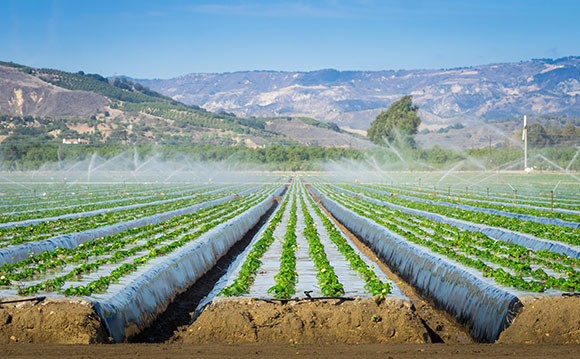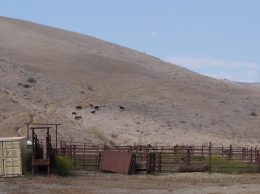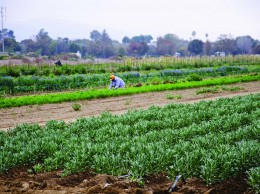
One of Ventura County’s many strawberry fields, visible from the region’s roadways. (Business Times file photo)
Ventura County Agriculture Commissioner Henry Gonzales told the Business Times that the county’s farm output will decline if the drought continues, but strawberries, the county’s No. 1 crop, would likely be the least affected because of their high return value.
Gonzales was interviewed about the water situation before speaking at an April 7 meeting on agricultural issues in Oxnard organized by Wells Fargo.
He said growers are already jockeying for leases, trying to find the ones that have quality water, and that is driving lease prices up. Ventura County already has the most expensive row-crop land in the state, he said, and probably in the nation.
“And so, when you look at two farmers, one growing strawberries and one growing another crop not as profitable, who’s going to be able to pay the higher lease? … Who’s going to win that negotiation? It’s going to be the strawberry grower,” Gonzales said.
The agricultural commissioner said the county’s strawberry farmers, whose harvest was valued at $608 million in 2013, had nearly the same number of acres in production during the current season as they have had over the past few years. The county’s crops had a total gross value of $2 billion in 2013.
Decisions are being made now about what fields to fumigate for next year’s strawberries, Gonzales said. One factor that could prompt some growers to move to a less lucrative crop is that the fumigant methyl bromide is being phased out and alternative chemicals are under scrutiny.
Concerns about that could lead some producers to shift to other berries or maybe to cut flowers. However, Gonzales said, “I believe for a number of years, people are going to stay in strawberries. We’re just so prepared for strawberries.”
Gonzales said that while there is no doubt the drought will reduce overall production, he cannot predict how it will affect revenues. Higher food prices are likely, he said, because farmers will have to pay their bills.
During his presentation, Gonzales talked about efforts to control or head off two agricultural pests in the county. The Asian citrus psyllid carries a disease that kills citrus trees. The polyphagous shot hole borer spreads fungal spores that kill avocado trees, among many others.
Gonzales said the citrus psyllid has spread from San Diego County all the way to Madera County since 2008. “At this point there are so many psyllids here in the county that some folks are just going to go out of business, there’s no doubt,” he said. In some cases, Gonzales said, he has used his authority to take over eradication measures from growers and bill them for it.
The polyphagous shot hole borer has been infecting trees in Los Angeles County and is on its way north, Gonzales said. Ventura County has deployed traps to check for the pest.
Michael Swanson, an agricultural economist with Wells Fargo, the nation’s largest farm lender, spoke about national and global issues affecting agriculture. He said U.S. agriculture has expanded at twice the rate of the national economy over the last decade instead of lagging, as was common before that. The growth has been fueled by national rules on biofuels that have bolstered the demand for corn, China’s opening of its huge market to agricultural imports, and U.S. monetary policy that has favored exports.
There are uncertainties about all three of those factors going forward, he said. What future standards will the U.S. set for ethanol in gasoline? Will China’s impressive economic growth become more cyclical? How much will an expected rise in U.S. interest rates boost the dollar and make exports less attractive?
“We’ve become an extremely export-intensive ag sector in this world,” Swanson said. “It makes sense. We do it well. … But it also makes us extremely sensitive to exchange rate issues.”
Swanson said California’s farm sector looks a lot different from the nation’s. The state leads in production of high-value fruits and nuts, with 68 percent of its revenue coming from those crops. It is also strong in vegetables and melons, accounting for 36 percent of sales.
The state’s dairy industry went through a huge slump in 2009, “but for those who survived, access to the global market for dairy has been incredible,” Swanson said. He called the hundredweight price of $25 for milk in 2014 a grand slam.
Swanson said the economic theme for agriculture over the years has been that demand will be strong, with the world’s population expected to reach 9 billion by 2050 and diets improving around the globe with rising income. But, he said, the industry’s survivors and thrivers will be determined by how they conduct their operations in volatile conditions.






 Print
Print Email
Email

















